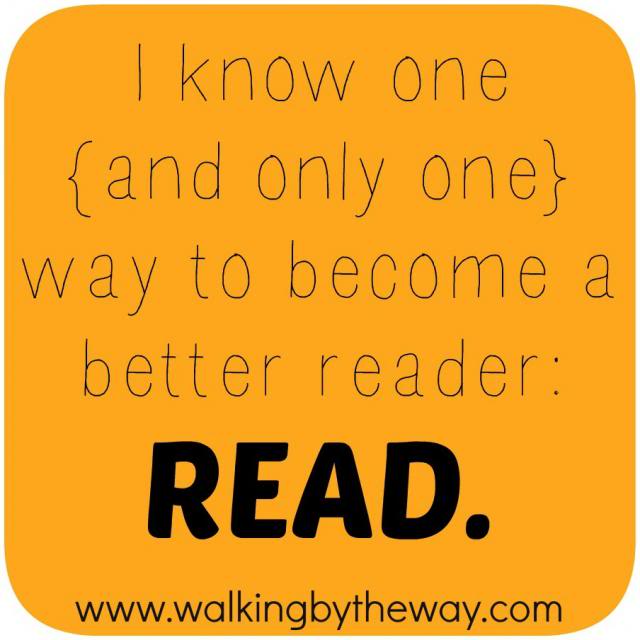
Simon has moved beyond BOB Books. And I had a panicky where-do-we-go-from-here? moment. You see, Reading Round 1 (with my first son, Elijah) was easy as he began reading when he was four. By 6 years old, he could read anything he wanted to read. All I had to do was supply the books.
Insert child #2. Very insightful. Very curious. And very much wanting to read big book, but he still needs to build reading fluency. It's not coming naturally for him like it did big brother. This is a new land for me, and I need a map to navigate my way through.
I will admit: I am not a reading expert. I will also admit: I am a mom who wants the best for her boy who is begging, "I want to read, Mom, so badly." I don't think I need to buy reading curriculum for him. He is already reading. He just needs more practice. You may think I'm simplifying things here, but I know one {and only one} way to become a better reader: READ.

Based on my belief, I set out to assemble a list of books to take Simon from beyond BOB books to beginning chapter books. I quickly learned there are different systems to organize readers and reading levels: Grade Level Equivalent, Guided Reading, DRA, and Lexile Measure–and probably more. It's madness. I wanted to shout, "Can the perfect reading list please step forward?" But nothing came.

I decided to cram four years of reading specialist education into one Saturday afternoon. I'm not sure I succeeded, but I got the basics. I continued to spend hours filtering through hundreds and hundreds of books in order to find quality and variety. At the end of my search, I put the titles in order based on my own combination of the reading level systems since they are based on different criteria and often conflicting.
I want Simon to read and re-read a book in order to develop stamina and to become fluid, confident, and ready to move up to the next level. How could I convince him to read Hop on Pop more than twice? A chart. A chart with incentives.
Insert Reading Charts. Books in a sequential order based on difficulty and length. They are listed on charts which, when completed, can (and should!) be rewarded.

It's simpleness.
I keep the current chart's books in a basket.
Simon looks at the chart and chooses a title to read.
He reads (to me, to Jason, or to Elijah). He puts a sticker on the chart.
When the chart is completed, he earns 25 points. He can save the points or redeem them for a prize based on our prize list.
You can make your own custom prize list by typing on the form below. Just click on the picture!
He moves on to the next chart.
It's working. He is gaining speed, accuracy, confidence, and he's even reading with inflection in his voice (which is pretty darn cute).
Starting next week, I will be sharing my Reading Charts to Build Reading Fluency with you.
I hope they will benefit another mom who has a reader needing one thing: practice.


Thank you for this wonderful idea. As a kindergarten teacher, we are pressed to 'fidelity' of the reading series. Even though I have a huge library for my classroom, I did not have a way to track independent reading. This chart system will be perfect for my readers of all levels, especially my transitional ones, as they grow towards lifelong readers.
I was wondering if you could give your 'criteria' for how you leveled your books. I love this idea and I think my daughter will too, but if we don't have some of the books you use in your chart, I would like to know what I could replace them with that would be on an equivalent level. Just wondering! Thanks!
Hi Bethany,
I spent a day learning about lexile measure. I looked for my favorite books and authors. Once I found about 120 books, I organized them in an Excel chart listing their lexile measure and grade level equivalent. Then I balanced the books because some may have a really low Lexile (20L) but a really high grade level (2.4). Others may have a high LM but a low grade level. (I also kept my eye on guiding reading level A-Z, especially when a book didn’t have a listed LM.)
I put a variety of books/authors on each chart, including some “real” books (Simon calls them real books because he knows they weren’t created for kids just starting to read. He wants to read “real” books, too. I also made sure there weren’t two Elephant & Piggie or Dr. Suess books on the same chart.
I hope this makes sense! I’m not very scientific, but I knew what I wanted! 😉
Thanks for your insight! 🙂 I am excited to have my daughter use this format to build fluency!
Thank you for this! My 5 year old has been reading easily since he had just turned 4 and I am struggling to keep up with him. He read 128 pg book yesterday and could explain the stories within it to me, so I know he's grasping it. This is such a great idea for him and he will love it!! Thank you!.